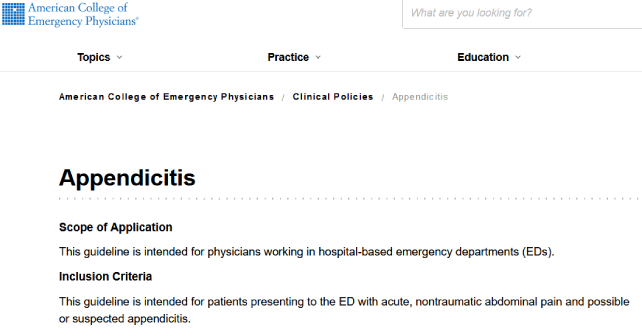
On February 1, 2023, the ACEP Board of Directors approved a clinical policy developed by the ACEP Clinical Policies Committee on critical issues in the evaluation and management of emergency department (ED) patients with suspected appendicitis. This clinical policy will be published in the June 2023 issue of the Annals of Emergency Medicine, and can be found on ACEP’s website and will also be included in the ECRI Guidelines Trust upon its acceptance.
Explore This Issue
ACEP Now: Vol 42 – No 03 – March 2023Abdominal pain is a high-volume, high-risk chief complaint. In 2016, patients with abdominal pain composed 8.6 percent of ED visits. Almost 200,000 patients are diagnosed with appendicitis each year. Missed diagnosis of appendicitis remains an area at high risk of litigation. Among children, appendicitis is the fifth most common cause of malpractice litigation against emergency physicians. The diagnosis of appendicitis can be challenging even in the most experienced of clinical hands.
This policy is an update of the 2010 ACEP “Clinical Policy: Critical Issues in the Evaluation and Management of Emergency Department Patients with Suspected Appendicitis.” This clinical policy is intended for patients presenting to the ED with acute, nontraumatic abdominal pain and possible or suspected appendicitis.
Based on feedback from ACEP membership, the Clinical Policies Committee conducted an updated systematic review of the literature to assess any needed changes to the 2010 clinical policy and to determine whether there was a need for additional evidence-based recommendations. After a thorough review of the literature, the topics of the 2010 clinical policy were updated or readdressed for this 2023 clinical policy. This 2023 clinical policy focuses on the identification of patients who are so unlikely to have appendicitis that they do not warrant imaging to confirm the diagnosis and patients with high clinical suspicion of appendicitis may be referred to a surgeon with minimal or no testing.
Critical Questions
1. In ED patients with possible acute appendicitis, can a clinical prediction rule be used to identify if no advanced imaging is required?
Patient Management Recommendations
Level A recommendations. None
Level B recommendations. In pediatric patients, clinical prediction rules can be used to risk stratify for possible acute appendicitis. However, do not use clinical prediction rules alone to identify patients who do not warrant advanced imaging for the diagnosis of appendicitis.
Level C recommendations. In adult patients, due to insufficient data, do not use clinical prediction rules to identify patients for whom no advanced imaging is required.
Pages: 1 2 3 | Single Page




No Responses to “ACEP Clinical Policy on Acute Appendicitis”